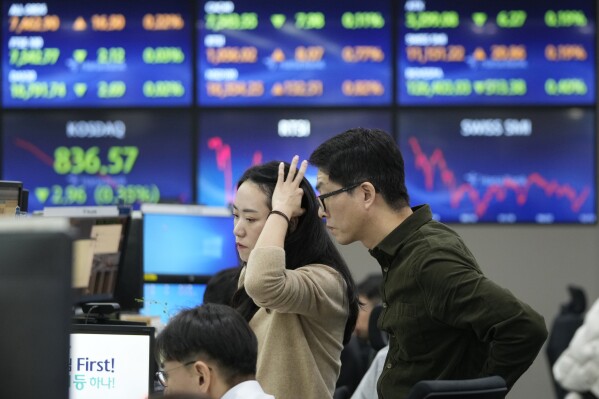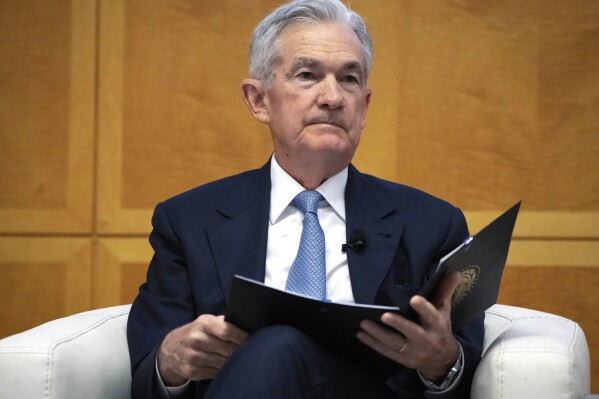Federal Reserve may shed light on prospects for rate cuts in 2024 while keeping key rate unchanged
WASHINGTON (AP) — Will the Federal Reserve cut its key interest rate sometime next year — and, if so, by how much?
Wall Street investors have been obsessed with such questions since a top Fed official hinted last month that rate cuts were at least possible as early as March. When its latest policy meeting ends Wednesday, the Fed will provide some highly anticipated hints about the extent of rate cuts next year. In the meantime, it’s set to leave its benchmark rate unchanged for the third straight time.
The Fed’s 19-member policy committee will also issue its quarterly economic projections, which include estimates of unemployment, inflation and growth over the next three years. Of most interest to Fed watchers, the projections include a forecast of how the central bank may adjust its key rate, which affects many consumer and business loans, over that period.
The average of all 19 forecasts will almost surely point to some rate cuts during 2024. Most economists expect Fed officials to project two, or possibly three, reductions.



Wall Street traders, who tend to be more optimistic, have bet on four rate cuts, according to futures markets, down from a prediction of five a few weeks ago. Their hopes for cuts were fueled last month when Christopher Waller, a leading Fed official who had pushed for higher rates since inflation erupted in 2021, surprisingly suggested that the Fed might decide to cut rates as early as spring if inflation kept falling.
With inflation mostly easing now, that would be a lower bar for rate cuts than the most likely alternative scenario: A sharp economic slowdown that could prompt even faster rate reductions. So far, though, there is no sign that a downturn is imminent.
Rate cuts by the Fed would reduce borrowing costs across the economy, making mortgages, auto loans and business borrowing, among other forms of credit, less expensive. Stock prices could rise, too, though share prices have already rallied in expectation of rate cuts, potentially limiting any further increases.
Fed Chair Jerome Powell, though, has recently downplayed the idea that rate reductions are nearing. Powell hasn’t yet even signaled that the Fed is conclusively done with its hikes. Speaking recently at Spelman College in Atlanta, the Fed chair cautioned that “it would be premature to conclude with confidence” that the Fed has raised its benchmark rate high enough to fully defeat inflation. He also said it was too soon to “speculate” about rate cuts.
Still, if the Fed leaves rates unchanged Wednesday, as expected, it would be the third straight time it has done so, lending weight to the widespread assumption that rate hikes are over. Beginning in March 2022, the Fed raised its key rate 11 times, to about 5.4%, the highest level in 22 years.
Typically, once the Fed has finished raising rates, attention quickly shifts to the question of when rate cuts will follow. Historically, on average, rate reductions have occurred less than a year after rate hikes have ended.
One reason the Fed might be able to cut rates next year, even if the economy plows ahead, would be if inflation kept falling, as expected. A steady slowdown in price increases would have the effect of raising inflation-adjusted interest rates, thereby making borrowing costs higher than the Fed intends. Reducing rates, in this scenario, would simply keep inflation-adjusted borrowing costs from rising.
Recent economic data have modestly cooled financial markets’ expectations for early rate cuts. Last week’s jobs report for November showed that the unemployment rate fell to 3.7%, near a half-century low, down from 3.9% as businesses engaged in solid hiring. Such a low unemployment rate could force companies to keep raising pay to find and retain workers, which would fuel inflationary pressures.
And consumer prices were mostly unchanged last month, the government said Tuesday, suggesting that while inflation is likely headed back to the Fed’s 2% target, it might take longer than optimists expect. The central bank, as a result, could opt to keep rates at their current level to try to ensure that prices resume their downward path.
Disclaimer: The copyright of this article belongs to the original author. Reposting this article is solely for the purpose of information dissemination and does not constitute any investment advice. If there is any infringement, please contact us immediately. We will make corrections or deletions as necessary. Thank you.





